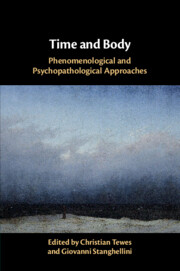Book contents
- Time and Body
- Endorsements for Time and Body
- Time and Body
- Copyright page
- Dedication
- Additional material
- Contents
- Figures
- Contributors
- 1 Introduction – Time and Body
- 2 Time, the Body, and the Other in Phenomenology and Psychopathology
- Part I Body and Time: General Aspects
- Part II Grief and Anxiety
- Part III Borderline Personality and Eating Disorders
- Part IV Depression, Schizophrenia, and Dementia
- 13 Intrinsic Temporality in Depression
- 13.1 Commentary on “Intrinsic Temporality in Depression: Classical Phenomenological Psychiatry, Affectivity, and Narrative”
- 14 Lost in the Socially Extended Mind
- 14.1 Commentary on “Lost in the Socially Extended Mind: Genuine Intersubjectivity and Disturbed Self-Other Demarcation in Schizophrenia”
- 15 Closing Up
- 15.1 Commentary on “Closing Up: The Phenomenology of Catatonia”
- 16 Embodied Selfhood and Personal Identity in Dementia
- 16.1 Commentary on “Embodied Selfhood and Personal Identity in Dementia”
- Index
- References
16 - Embodied Selfhood and Personal Identity in Dementia
from Part IV - Depression, Schizophrenia, and Dementia
Published online by Cambridge University Press: 30 October 2020
- Time and Body
- Endorsements for Time and Body
- Time and Body
- Copyright page
- Dedication
- Additional material
- Contents
- Figures
- Contributors
- 1 Introduction – Time and Body
- 2 Time, the Body, and the Other in Phenomenology and Psychopathology
- Part I Body and Time: General Aspects
- Part II Grief and Anxiety
- Part III Borderline Personality and Eating Disorders
- Part IV Depression, Schizophrenia, and Dementia
- 13 Intrinsic Temporality in Depression
- 13.1 Commentary on “Intrinsic Temporality in Depression: Classical Phenomenological Psychiatry, Affectivity, and Narrative”
- 14 Lost in the Socially Extended Mind
- 14.1 Commentary on “Lost in the Socially Extended Mind: Genuine Intersubjectivity and Disturbed Self-Other Demarcation in Schizophrenia”
- 15 Closing Up
- 15.1 Commentary on “Closing Up: The Phenomenology of Catatonia”
- 16 Embodied Selfhood and Personal Identity in Dementia
- 16.1 Commentary on “Embodied Selfhood and Personal Identity in Dementia”
- Index
- References
Summary
It is the aim of this chapter to explore the intertwinement of embodied selfhood and personal identity in dementia. According to the cognitivist picture of personal identity prevalent in the scientific literature and public debate, severe cases of dementia, where there is a loss of declarative memory, linguistic capacities and social orientation, effectively turn the patient from a person into a nonperson. After critically analyzing the arguments and assumptions behind this conclusion, I introduce the concept of “embodied selfhood” as a counterview. I argue that even in severe cases of dementia – such as late-stage Alzheimer's disease – the manifold expressive forms of embodied selfhood justify the continued ascription of embodied personal selfhood.
- Type
- Chapter
- Information
- Time and BodyPhenomenological and Psychopathological Approaches, pp. 367 - 389Publisher: Cambridge University PressPrint publication year: 2020



